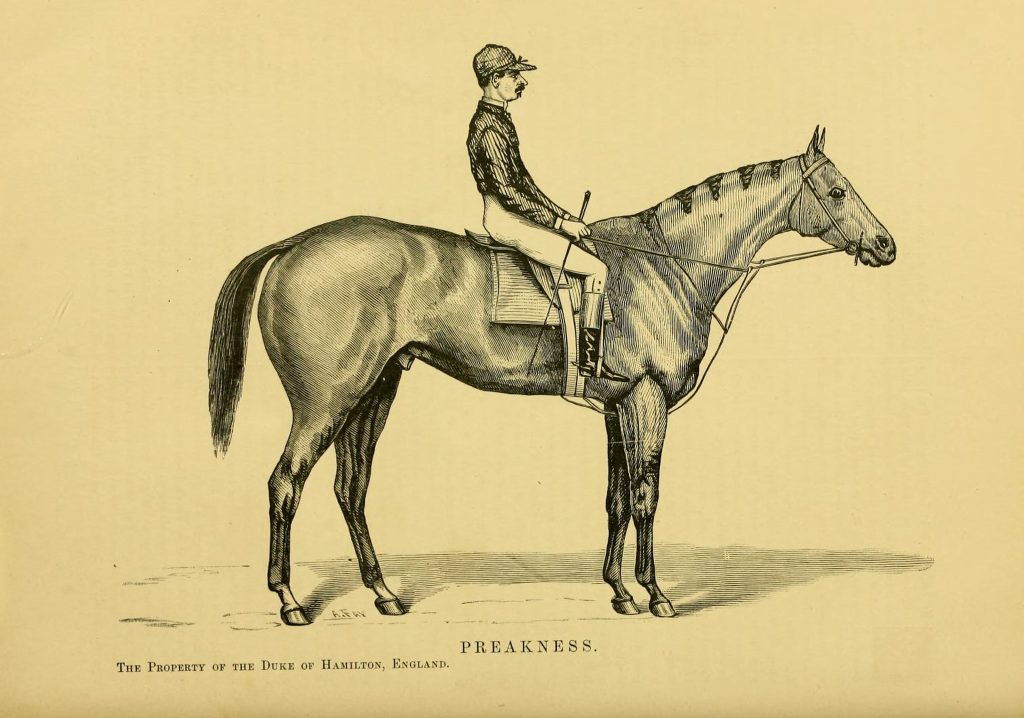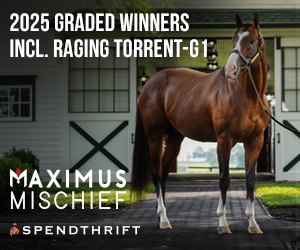
By Peter Lee
Two of the three Triple Crown races are named after the place where they are located: the Kentucky Derby in Louisville, Kentucky, and the Belmont Stakes at Belmont Park in New York. The Preakness Stakes, however, is not called the Pimlico Stakes or Maryland Stakes. It, like so many races today, was named after a horse, a colt named Preakness.
Preakness was born in 1867, a dark bay colt who was the son of Bay Leaf and Lexington, one of the greatest stallions who ever lived. Lexington was the leading sire in North America for 16 years and was the sire of the undefeated Asteroid. His progeny won nine of the first 15 Travers Stakes.
The colt was named for Preakness Stables, which was in turn named for the New Jersey town where it was located. The name of the town came from the Indian word “Praquales,” which meant “quail woods.” He was purchased by Milton Holbrook Sanford for $4,000—a good price for a colt that was big, ungainly, and not pretty to look at. His feet were so big as a 2-year-old that he didn’t even race. His handlers joked that any time he could stand and eat at the same time was a moral victory.
To make matters worse, he was a rambunctious horse, biting and kicking handlers and throwing riders frequently. But when his body caught up with his feet, he turned into a racing machine, standing at over 16 hands.
The ‘Dinner Party Stakes’
At the same time Preakness was growing into his body, Maryland Governor Oden Bowie and some friends held a formal dinner party one evening in 1868. After dinner, over cigars and scotch, several of the gentlemen began talking about their horses. The talk turned into a challenge, and the men agreed to hold a two-mile race to see whose horse was the fastest when they turned 3 years old.
The only problem was they had no race and no course to run it on. So Bowie had a brand new race course built in Pimlico, a small town near Baltimore. The winner would have to host the losers for a dinner party, so the race was called the Dinner Party Stakes.
The race took two years to come into fruition as the course was built, and at the inaugural running of the Dinner Party Stakes at the new facilities in 1870, Sanford entered Preakness, now 3, for his first race. He obviously wasn’t the favorite. That honor belonged to Foster, who had won the Double Eagle Stakes, finished second in the Belmont Stakes and had just won the Lambard Stakes eight days previously. Four of the eight starters were by Lexington.
About 12,000 people were in attendance at Pimlico’s opening day, October 25, 1870. The Dinner Party Stakes was the third race on the schedule for the day. As the horses lined up, the judges called a false start, but once they were in place again the race was on. A filly with the crowd-pleasing name of My Maryland took a slight lead, followed by Finesse. My Maryland stayed ahead for the first half-mile of the race but was closely pressed by Preakness, who passed her and claimed first passing the judges’ stand for the first mile.
During the second mile, another filly, Ecliptic, ran past Finesse to take over second and set her sights on Preakness. She passed him and held a half-length lead on the turn, but Preakness was not to be denied. He fought back in the homestretch and won the two-mile race by a wide margin in a time of 3:47 1/2.
When Pimlico opened its spring meet in 1873, the premier race for 3-year-olds was named in honor of the winner of the first Dinner Party Stakes. Survivor won the first Preakness Stakes while Preakness was still racing as a 6-year-old.
In fact, Preakness would go on to win many races, including the Maturity and Pimlico stakes in 1871; the Grand National and Jockey Cub handicaps in 1873; the Jockey Club Stakes in 1874; and the Saratoga Cup in 1875. He raced until he was 9, and his final record stood at 18 wins, 12 seconds and two thirds in 39 starts. He finished out of the money only seven times.
Tragedy Strikes
Preakness was sold to the 12th Duke of Hamilton around 1875 and shipped to England to run. The Duke, an ill-tempered man described as having “a frankness of speech bordering on rudeness,” did not get along well with the horse. One day Preakness would not listen to Hamilton during a breeding session. The horse kicked the Duke, who, in a fit of rage, marched up to the house, came back with a shotgun, and shot and killed the horse on sight. This incident led to public outrage in England that resulted in new laws targeting animal abuse.
Names of races have come and gone, but Preakness will forever be remembered as the namesake for the second race for the Triple Crown. His legacy was cemented in 2018 when he was inducted into the National Museum of Racing and Hall of Fame.
Image Courtesy Of The National Museum Of Racing and Hall Of Fame



